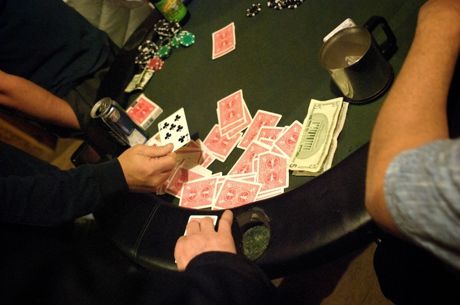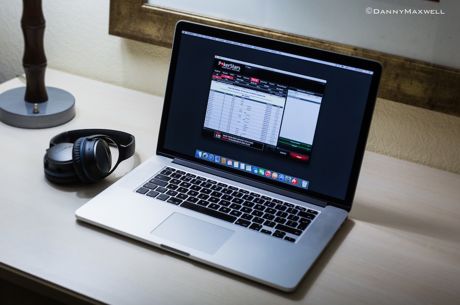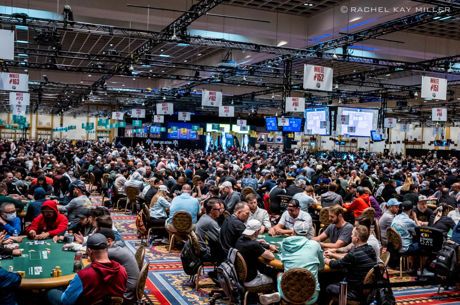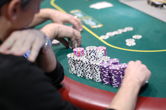A Preflop Question: Is Limping Lame?
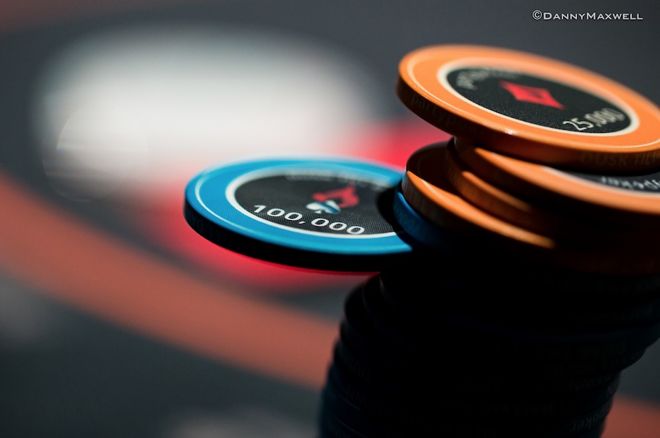
Poker author Steve Selbrede (The Statistics of Poker, Beat the Donks, Donkey Poker) continues his strategy series on low-stakes Las Vegas cash games.
One of the strongest poker mantras we hear is "never limp!" Or at least: "never open-limp." The "raise it if you play it" attitude is nearly universal among strong online poker players and professional live players. So it must be good advice, right?
As usual, the answer is it depends.
Open-Limping Online
Let's begin by considering a statistical analysis of online NL50 and NL100 full-ring no-limit hold'em.
Figure PN6-1 below shows the profit made by the most experienced online players as a function of how often they open-limp. This database includes six million hand histories and the curves are based on the 2,000 players with the most dealt hands.
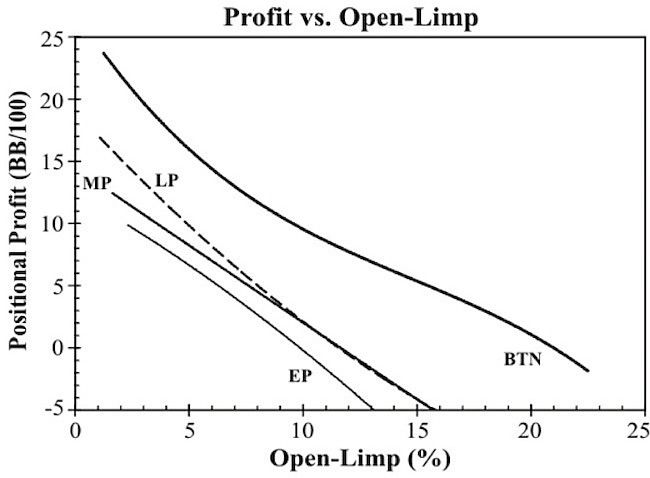
We can see that open-limping reduces our profit, regardless of table position. Maximum profit occurs at the lowest rate of open-limping. Since there are few players in the database who never open-limp, the curves don't quite reach zero. But it is clear that our maximum profit is at zero open-limping.
This doesn't necessarily mean that open-limping is unprofitable. It simply means that open-raising is more profitable than limping. Thus, the pundits are on solid statistical ground when they advise against open-limping.
Limping Behind Other Limpers Online
By comparison, limping behind other limpers might seem to be more reasonable, since our implied odds improve once additional players are in the pot. Figure PN6-2 shows the profit made by experienced online players as a function of how often they Limp With Previous Callers (LWPC).
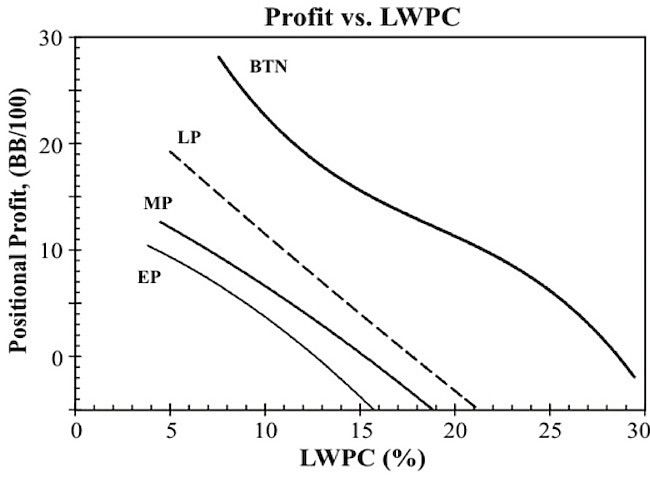
Again we see that the most profitable players limp behind the least often. This is true for every table position. In fact, there is no sign at all that these curves are beginning to bend downward at the lowest LWPC percentages, which would imply that our maximum profit would occur at some low percentage. So it's clear that we should rarely, if ever, limp behind other limpers.
There is a caveat to this result, however. Online players rarely have LWPC opportunities with more than one limper ahead of them. So the incentive to limp behind a single limper is a weak one. If the online game produced a lot of limped family pots, limping behind might sometimes be favorable.
Online Limping is Weak
These curves tell us that when we are playing online poker and are given an opportunity to open, we should always fold or bet. When we have an opportunity to limp behind, we should rarely (if ever) limp.
The fundamental reason is simple �� online players are aggressive and will often attack limpers. A limp might conceivably be the best play when we know it will survive to see a flop. But our limp is immediately unprofitable when we are forced to fold to a raise. Calling the raise can be even more unprofitable when we chase with a hand we did not think was strong enough to raise.
If we are raised off our limp too often, limping becomes less profitable than folding or raising. We don't really need to analyze the balance of the pros and cons; the online statistics show that the balance is tilted against limping from any table position.
Most poker books are written by high stakes or online professionals. They have learned that limping doesn't pay off, so they recommend against it.
Limping in Low-Stakes Vegas Games
As we've discussed before, there are significant differences between low-stakes Vegas poker and online poker. Some of the key differences are summarized in Figure PN6-3. In principal, these differences might shift the balance in favor of limping in the low-stakes games.
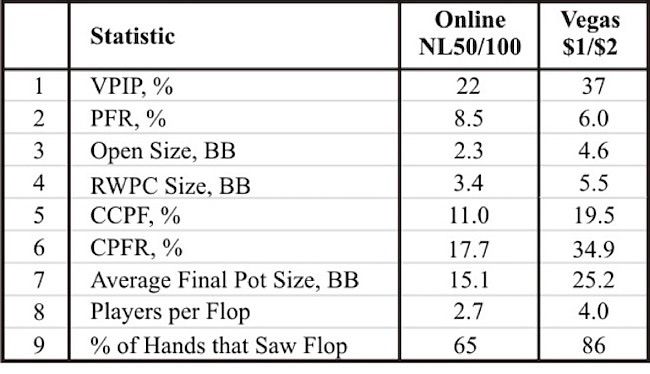
To begin with, the average online open bet size is only 2.3 BB, compared to 4.6 BB in a Vegas $1/$2 game. Furthermore, this opening raise is called about twice as often in the Vegas game (CCPF or CPFR).
That means a Vegas player's open-raise risks twice as much and is called twice as often �� and for the same 1.5 BB reward. This is the genesis of the lament "I can't beat these donkeys. They don't know how to fold. I'd rather play better players."
But the solution isn't to play stronger players. It is to adapt to what the weak players are doing. They don't raise! They don't fold!
We can also see that we face more players on the flop in the Vegas game. It's much easier to win an online pot when facing a single out-of-position villain than it is to win a four-way Vegas flop without position. So we should be more reluctant to raise light in the Vegas game.
Suppose we have 6?6? with an open opportunity, three off the button. Our online style is approximately 16/13 (VPIP/PFR), so we open to 2.5 BB. Usually, we take down the pot immediately or play it heads-up.
But in a typically passive Vegas $1/$2 game, we open to 5x the big blind and get three callers. Furthermore, we will usually be out of position versus at least one of our opponents. It will be difficult to earn a profit in this situation, even if we have mad postflop skills. It's probably a losing play for most strong players, and a big loser for an average player.
So what should we do? If we simply fold all of our speculative hands, such as low pairs and suited connectors, we become a nit, which is not the path to crushing the low-stakes Vegas game.
Our other option is to limp with some of these hands. This works for two primary reasons.
- In a typically passive Vegas $1/$2 game, a middle-position limp is likely to survive. With an average PFR of 6 percent and with five players behind, our limp will survive about 73 percent of the time, perhaps 80 percent with typically passive Vegas players in the blinds. Limping with certain speculative hands becomes profitable when we rarely get raised off of our limp.
- The average Vegas pot size is much larger than it is online. There are far more players per flop, especially in limped pots. And low-stakes Vegas players are much more likely to pay us off when we hit big. This basically means our implied odds for limping with certain speculative hands are much better in the Vegas game. But raising with these same hands reduces our implied odds by decreasing our postflop Stack/Pot Ratio.
The analysis of which "certain speculative hands" we can limp with depends on a fairly complex mathematical model, something I describe in great detail in Donkey Poker Volume 1: Preflop. The result is a "Donkey Games Starting Hand Chart" that produces an approximately 18/9 (VPIP/PFR) overall stat. This is a little looser and a little less aggressive than the online optimum of 15/12.
Also in this series...
- Low-Stakes Live Games Differ from Online
- Do You Play Too Many Hands?
- Are You a Position-Dummy?
- When Can I Take a Bathroom Break?
- Is Straddling a Good or Bad Play?
- Maximizing Expectation When Betting For Value
- Maximizing Expectation When Betting as a Bluff
- Five Weak Reasons to Bet (and One Weak Reason Not To)
- Do You Have 'Jack-O-Phobia'? Playing Pocket Jacks in Live NL Hold'em
Steve Selbrede has been playing poker for 20 years and writing about it since 2012. He is the author of five books, The Statistics of Poker, Beat the Donks, Donkey Poker Volume 1: Preflop, Donkey Poker Volume 2: Postflop, and Donkey Poker Volume 3: Hand Reading.
In this Series
- 1 Donkey Poker: Low-Stakes Live Games Differ from Online
- 2 Donkey Poker: Do You Play Too Many Hands?
- 3 Donkey Poker: Are You a Position-Dummy?
- 4 Donkey Poker: When Can I Take a Bathroom Break?
- 5 Is Straddling a Good or Bad Play?
- 6 A Preflop Question: Is Limping Lame?
- 7 Maximizing Expectation When Betting For Value
- 8 Maximizing Expectation When Betting as a Bluff
- 9 Five Weak Reasons to Bet (and One Weak Reason Not To)
- 10 Do You Have 'Jack-O-Phobia'? Playing Pocket Jacks in Live NL Hold'em
- 11 Donk Betting in Small-Stakes Live No-Limit Hold'em

